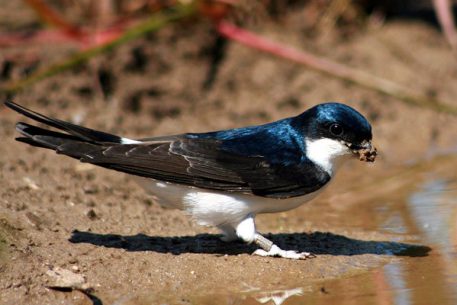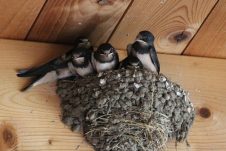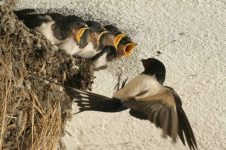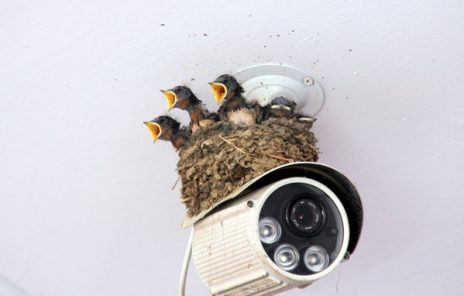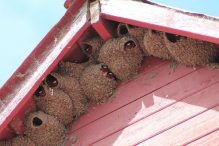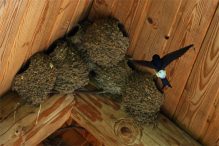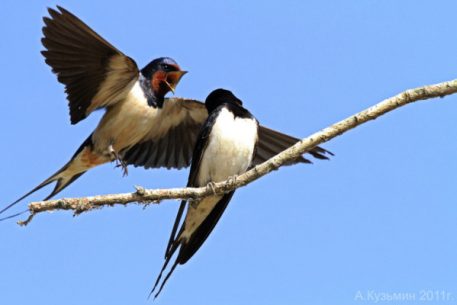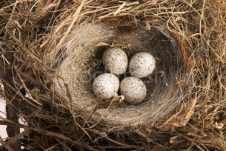These sonorous birds with their twitter attract the attention of residents of large cities and small towns. City swallows live next to people, which is why they got this name. How to distinguish these birds from their counterparts, where they build their nests, how to feed and breed - the answers to these questions can be found in our article.
Material Content:
Description of the city swallow
Like other funnels (the second name of these birds) - Eastern and Nepalese, the swallows have a contrasting color. These birds of the order Passeriformes differ from other representatives of the Swallow family in the color of their plumage.
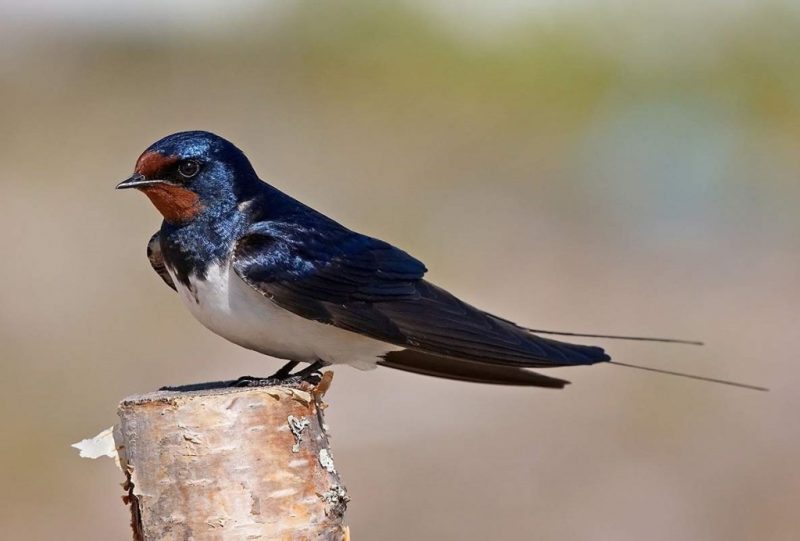
- The black upper torso and head are characteristic of all swallows, but in urban ones they often have a bluish tint.
- White breast, abdomen and lower parts of plumage - without interspersing other tones (red or black).
- The birds have brown eyes, a small black beak, on short legs - white fluff.
- In short, than with other members of the family, the tail is black above and white below, with a clearly defined triangular notch at the end.
The weight of the birds is small, varies depending on gender. Males have 16 - 22 g, and females reach 19 - 24 g. The body length in both sexes is approximately the same - from 11 to 17 cm, wingspan - 26 - 30 cm.
In flight, birds reach speeds of up to 11 meters per second. Flying, they make characteristic sounds similar to tweets.
Bird habitat
Voronkov is divided into two subspecies:
- European, whose representatives live in Europe, northern Africa and Asia (west of the Yenisei);
- Siberian, living in the north of Mongolia and China, in Siberia (east of the Yenisei).
Initially, the original habitats of the birds were sheer mountain cliffs, rocky shores of reservoirs, where they built their nests in grottoes and ravines.But gradually this species migrated closer to the houses of people.
City funnels nest under the roofs of houses, bridges, balconies, arches and other sheer architectural buildings. Most often found in large cities, where there are more buildings made of stone materials, but in rural areas you can also see this kind.
Lifestyle swallows
In countries with a temperate climate and a comfortable temperature, birds live all year round. In a cold climate, as in our country, swallows, beginning in late August, migrate to southern countries. During flights, a significant part of the flock dies.

Returning back, birds can occupy old nests, and can build new ones. The fallow period begins in the spring, when the males, having looked at a place convenient for nesting, lure the female with their flights and singing.
The sounds these birds make are special. Different shades of sound indicate the physical condition of the individual at that time. The female can judge by the song of the male about his ability to mate. There are also special signals that indicate danger or excitement.
After the breeding season, funnels form flocks, they can often be seen sitting on wires, they collect food together, flying over the fields. These birds are characterized by high sociality, you can not meet lonely city swallows. This behavior protects birds from predators. You can often see how, at the sight of danger, the whole flock begins to circle and drive away an unwanted guest with loud noises.
Birds spend most of their lives (about 90%) in the air, they even feed their chicks. On the ground, funnels feel insecure due to short paws.
Birds are not afraid of people, therefore they settle near them. And there is another sign: where city swallows build their nests - there will be happiness, harmony and joy in that house.
Where to build their nests
Already after 7 - 10 days after arrival in April / May, birds begin to build nests. Usually the process lasts about a week, it all depends on the weather. New couples try to nest close to old nests.
Birds equip a place for planting chicks on the vertical surface of stone or brick buildings, rarely - wooden.
Among the places where you can see the nests of city funnels, there are:
- caves;
- sheer cliffs;
- grottoes;
- high rocky coasts;
- gorges;
- bridges;
- eaves of high-rise buildings;
- window niches;
- doorways;
- arches;
- balconies;
- the roof.
A male and a female take part in the construction, they carry materials for the nest in their beaks:
- blades of grass;
- fluff;
- feathers;
- dry stems;
- feathers;
- mud from puddles;
- wet ground.
The construction has the form of a neat oval bowl with thick walls. The entrance to the nest is from above, it is very narrow, even sparrows trying to grab housing for future chicks cannot penetrate it. The height of the finished nest is about 15 cm, in diameter it has 10 - 20 cm.
Inside the bird, the nest is lined with soft materials so that it is convenient to lay eggs and hatch chicks.
Often the birds of one colony build their nests almost back to back with each other, they can even stick together.
Returning from warm countries, the swallows settle in their old nests, only equip them with a new inner lining. If the previous structure is destroyed, birds can repair it.
What the city swallow eats
The diet of these birds is based on different insects. A funnel grabs its food on the fly in the city, in the forest, over meadows, rivers and lakes.
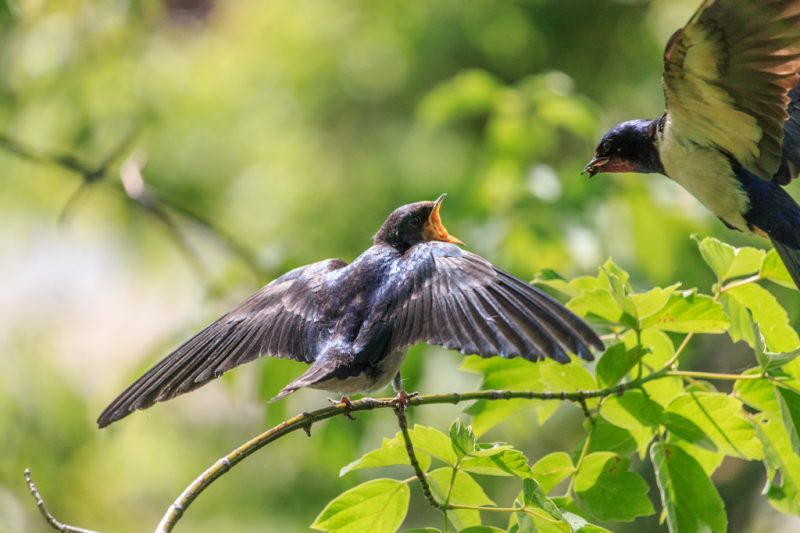
Food served:
- flies;
- mosquitoes;
- butterflies;
- beetles;
- midge;
- grasshoppers;
- horseflies;
- spiders.
Swallows avoid toxic wasps and bees.
Clear weather promotes hunting. In the rainy season, birds rarely fly out for prey, while the flight altitude drops sharply.
Reproduction and longevity
City swallow - monogamous look. A couple is formed by birds in early spring, after arriving from the south, and it remains for life.
The mating process begins with a loud twitter of a male who is trying to attract a female. He has already found a place for the nest, and when the choice is made, the couple together builds housing for future chicks.
From early June to mid-August, the female lays eggs twice. One brood has on average 4 to 6 white eggs. Chicks hatch in turn: while the female hunts, the male sits in the nest, then vice versa.
The hatching period is 14 to 20 days, depending on the weather. Tiny chicks appear - up to 4 cm, blind and without feathers.
For 3 weeks, parents feed their children, for this they have to fly up to 300 times a day for food.
Chicks fledge and see well during this time. Then the chicks are taught to fly and find their own food, after which they become completely independent.
Young growth leaves the nests of parents and adjoins a wandering flock. There are times when chicks from the first brood help parents feed the second brood. They reach puberty a year later.
City swallows do not live long. In harsh flight conditions, almost half of the flock, and in some cases all individuals, die. On average, funnel life expectancy is 4 years.


